|
|
Review Fujitsu Siemens Pocket LOOX 610
Standard kit:
- PDA
- Docking station
- Charger
- Case with the clip
- CD with software
- User's guide

Last year [2002] the original Pocket LOOX 600 by Fujitsu Siemens Computers competed with HP iPaq 3970 to be the best handheld of the year. It was among the first models with new Intel XScale 400 MHz processor, built-in Bluetooth (the rarest feature then), modern design and dual expansion slots. In all, the model unexpectedly experienced a successful debut. Everybody looked forward to its heir.
When we examined next model from the PDA line by Fujitsu Siemens it became evident that the Pocket LOOX 610 wouldn’t resume the success of its predecessor. The design has been changed dramatically, and the model has lost smooth lines that decorated the LOOX 600. No wonder, the handheld is based on the reference-design by Asus (Asus MyPal A716), but the software has been revised. The LOOX 610 features larger dimensions, heavier weight and the external antenna (meanwhile competitors do the reverse). That’s not the only reason that prevents the model from being a mass one – we’ll summarize it in the conclusion.
Before the main review I’d deviate from the key point taking into account the fact that there are two wireless adapters integrated into the model – Bluetooth (commercially known as the IEEE 802.15.1 standard) and Wi-Fi (IEEE 802.11b). Whereas mobile phones acquire more functionality and approach to Pocket PC (partially duplicating their functions), handheld computers come with integrated GSM/GPRS/CDMA modules. Very soon it will difficult to tell the mobile phone from the personal digital assistant. The process is inevitable and runs from two sides to the same destination point. A temporary solution involves the PDA-phone link via Bluetooth. Thus where cellular networking is possible, you can always get connected with the Internet or check your mailbox on the PDA using a Bluetooth phone. Another wireless standard is Wi-Fi that isn’t an alternative to Bluetooth, it has other opportunities, tasks, distance range, speed and power consumption. To some extent Bluetooth substitutes for IR, and Wi-Fi in its turn alternate the wire local area network. Consequently you get the following services: the access to local resources, the internet and IP-telephony. The world now is experiencing a real Wi-Fi boom (mostly in the USA), hot spots spring up. However it’s not the case with Russia – Wi-Fi only paves its way here. The Wi-Fi standard (and recent modifications IEEE 802.1x) is considered as an alternative to 3G, though it’s not the matter in the assessment. Well, recently there have appeared handhelds combining two standards Wi-Fi and Bluetooth. The idea is simple. Within the local area network (home/office) we use the high speed networking via Wi-Fi to get access to the Internet. Inside that zone we keep the access now via Bluetooth, though more expensive and at slower speeds. Naturally it’s not the only way to apply wireless standards. But, let’s pass over to our review.
ÏAs for the design the device looks like a brick, strict and without smooth angles. It’s a massive Pocket PC with 147.5x78x18.2 mm, the iPaq 1940 seems a miniature compared to it. Weighing 200 g it can hardly be called a handheld. Wear it on the belt or in the pockets of your overcoat. Otherwise it would impede you and you risk breaking off the external antenna. Despite its size, however, there is nothing wrong with the ergonomics of the handheld; it is quite long, but can still be held comfortably. Many (not the majority) will like it.

The control buttons on the front side resemble the design of the original model. Below the screen there are four application buttons and a comfortable joystick (like in the Pocket LOOX 600). You may assign buttons to launch applications on a short/long push, thus the number of buttons virtually double. Other handhelds enable the function only with the help of exterior programs, but the solution is already built in the new LOOX. Another peculiar feature involves the FSC KeyLock utility that prevents a wake up at occasional key strokes. To the right there is the dynamic that is neither quiet nor too loud. The power button and two LED indicators are located above the screen. The left one stands for the wireless adapter – it glows blue when Bluetooth or Wi-Fi is active, the right one indicates the charge.
The left side contains “up”, “down” and “enter” buttons which replace the scrolling wheel, they are easy to use and perfectly fit the left thumb. Note that PDA makers prefer common buttons to the jog dial. A soft reset button and the infrared port are conveniently placed below these buttons.


At the top of the device there rest two slots for extension (SD/MMC and CF), the silo, the headphones jack and a twisting antenna. The headphones sound traditionally loud. The right side hides the charger plug: you can recharge the handheld without the cradle, that’s convenient when you are far from home. At the bottom there is the plug that joints the device with the cradle or a cable. The microphone is placed to the right (not very convenient). The recording quality stays satisfactory, the maximum distance makes up a half meter. You can set the volume level and microphone sensitivity.

The cradle and the case with the clip look ordinary, nothing attracts special attention. Just see the photos below.



Screen
It’s a traditional screen for Pocket PC: transflective, 3,5” diagonal, 65K colors, 240x320 pixel resolution. This is typical of most current PocketPC’s including low-end ones. It is very easy to read indoors and outdoors viewing the screen from different angles. The screen is clear, sharp, and does a good job reproducing colors. The minimum backlight is too bright to use the handheld in the dark for a long time (for example when reading e-books). Most handhelds with transflective screens suffer from “the problem”. There may arise a question, why the diagonal measures just 3,5”, there is enough space for 4”.
Off-line work
The Pocket LOOX 610 is fed by a 1500 mAh swappable Li-Ion battery. The producer claims up to 12 hours of the off-line work. At the maximum load the LOOX 610 lasted just 3 hours (400 MHz frequency rate, full screen brightness, video and mp3 mode). With Bluetooth switched on (we used the Internet and ICQ via ActiveSync) the handheld was good for 6,5 hours on a single charge, the result surpassed average figures. An optional 3000 mAh battery is available if you want to double the off-line performance.

Productivity
The dual-wireless model comes with excessive 128 MB of RAM. The junior modification (without Wi-Fi) has standard 64 MB.
The LOOX 610 runs an Intel XScale PXA255 at 400 MHz – dealing with processors it’s difficult to be original. You can operate the Pocket PC in different frequency modes, which can be set manually or automatically.

Traditionally we used the SPB Benchmark package to test the productivity. For this purpose we’ve chosen analogous models – the original LOOX and Asus A620.

The CPU index describes Pocket PC’s CPU speed. The test delivered almost the same results. The Pocket LOOX 610 wins some millimeters.
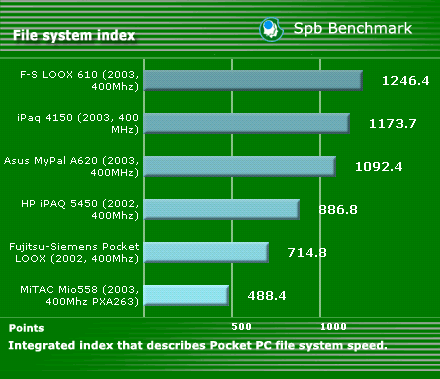
The file system index describes Pocket PC file system speed (read/record/move). The model from Fujitsu Siemens leads with a better gap. MiTAC Mio558 stays far behind because of its cheap memory.

The platform index of the LOOX 610 shows the best results again. The results correspond to that of the previous test with the Mio558 lagging behind.
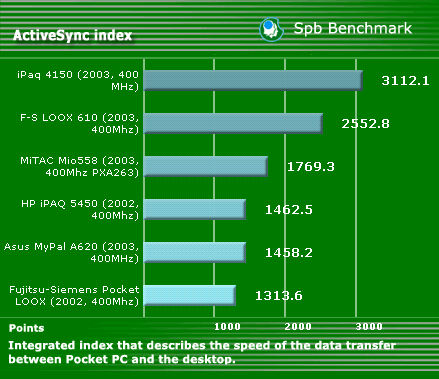
The synchronization speed of the data transfer between Pocket PC and the desktop reveal another leader HP iPaq 4150. The Pocket LOOX 610 catches up with it this time.
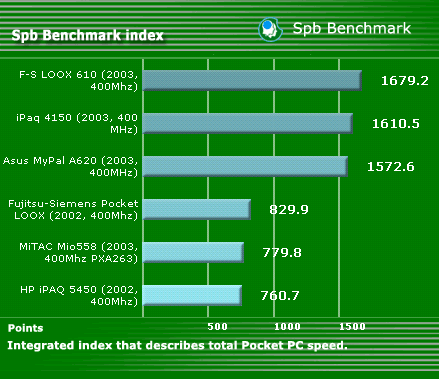
ÏThe total productivity figures confirm the leadership of the Pocket LOOX 610. There is nothing surprising as the handheld is stuffed with Asus fillings (Asus MyPal A620 proved to be a very productive model).
We tested graphics with PocketQuake game in the mute mode (turn the sound off by nosound 1 console command leaving other settings on).

As you see FSC Pocket LOOX 610 turned to be the most productive handheld nowadays [January 2004]. However you should realize that such productivity would be appropriate while playing resource-heavy games. It surpasses HP iPaq 4150 or Asus A620 by feeble percents, you’ll hardly see the difference. Nevertheless the status “the most productive Pocket PC” will burst sales.
Interface
The Pocket LOOX 610 is equipped with two slots for extension (SD/MMC and Compact Flash). You may load the Compact Flash slot with GPS or GSM/GPRS-receiver, and the SD/MMC slot with extra memory.
As for the infrared port you can switch over the transmission rate from FIR to SIR.

Two wireless adapters do not function simultaneously, only by turns. Thus there is no theoretical chance to maintain a continuous roaming between Wi-Fi and GSM/GPRS networks and to use a Bluetooth headset during an IP session. It’ll take you dozens of seconds to switch on/over the adapters. For example, in HP iPaq 4150 adapters work simultaneously and can be launched within a second.
For the second time Fujitsu Siemens uses its own FSC Pocket Plugfree manager instead of standard Bluetooth drivers by WIDCOMM. It’s less comfortable and less stable compared with drivers by WIDCOMM, however it got much better against the version for the Pocket LOOX 600. For example, you should keep the Bluetooth manager always open even if Bluetooth is already active, it takes the application another twenty second to initialize. The synchronization between Pocket PC and the desktop through ActiveSync (AS) performed well, after the end of the synchronization the connection doesn’t get broken like before. There were also no problems with the data transfer via Bluetooth. However the connection with the Internet via the mobile phone almost failed. It took us a minute to tune the connection (including setting the partnership with the phone), however the active connection got broken in several minutes. Under such conditions you won’t use the Internet for a long time. The problem has been inherited from the previous model, though it may be solved soon. The SMS manager provided the correct work with the SMS. Before you start Bluetooth carry out some settings:
 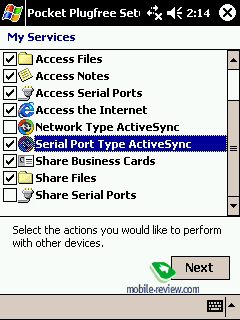
 
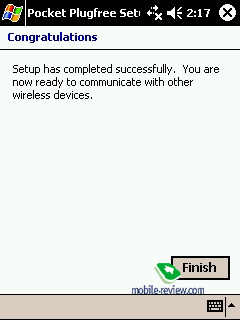
Bluetooth active (follow the power consumption settings):
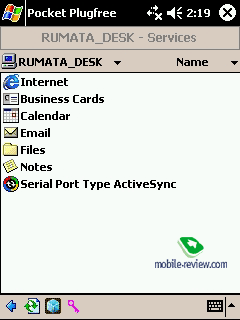 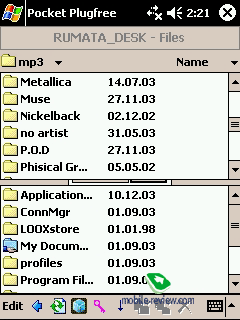
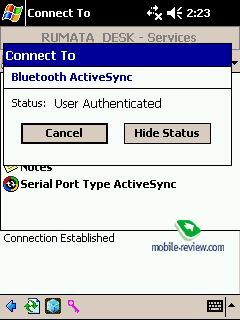 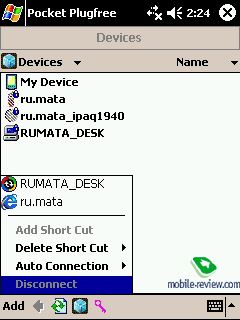

Software
The Pocket LOOX 610 is powered by Windows Mobile 2003 for Pocket PC Premium Edition. Read about standard applications for this operating system in the respective review on our site. There is the package of extra applications already preset in the handheld.

FSC CONNECT2AIR – this application switches on/off wireless adapters and quickly launches relevant settings, by default this function is assigned to one of application buttons.
 
FSC Backup – the program executes a backup. Unfortunately you can't run it on the schedule.

FSC SpeedMenu – the application enables a quick access to programs, documents and folders. To launch it you should press long the “enter” button on the left side. You can run it from the drop-out menu. Regarding functionality matters the SpeedMenu loses to other managers by exterior developers.
To the Russian market it is shipped fully russified by Paragon (including the manuscript input). The species we’ve tested had no russificator, so we can’t judge. As the bonus the handheld comes with English-Russian (Russian-English) Multilex 4.0 dictionary.
Conclusion
The model comes in two variants: with and without Wi-Fi. Let’s summarize both of them.
“The model without Wi-Fi”. With its dimensions, weight, design and price it loses to analogous handhelds: HP iPaq 2210, Toshiba E750BT, Asus A620. It doesn’t seem attractive for $470-500. If you deliberately need Wi-Fi, so think of the dual wireless adapter version. The model offering both Bluetooth and Wi-Fi has two serious rivals. The MiTAC Mio 558 features smaller size, lighter weight, the absence of the external antenna and better price. However wireless adapters also do not work simultaneously. The next rival is the iPaq 4150. It’s a tiny model with two wireless adapters that work perfectly. There is no Compact Flash slot – a decisive criterion to choose a handheld. As the result the Pocket LOOX 610 won’t enjoy mass popularity like its predecessor, still it has the target users, whose looking for the maximum functionality, high productivity and good off-line indices.
General features
- Class: business
- Position in the PDA line: above F-S Pocket LOOX 600
- Rival models: MiTAC Mio558; HP iPaq 4150/4155
- Operating system: Windows Mobile 2003 for Pocket PC Premium Edition
- Processor: Intel XScale PXA255 400 MHz
- ROM: 128 MB RAM (122,79 MB available to the user), 64 MB for the Pocket LOOX 610 BT
- LOOXstore (nonvolatile memory available to the user): 28,14 MB
- Connectivity: SD/MMC, Compact Flash Card type I/type II, fast IrDA (FIR), Bluetooth, Wi-Fi (802.11b) for the Pocket LOOX 610 BT/WLAN, serial (RS232)
- Bluetooth profiles: BNEP, DUN-DT, FT-Client, GAP, File Transfer, Object Push, OPP Client, Point to Multipoint (PAN), FT-Server, LAN-DT, Point to Point (LAP), OPP Server, PAN-User, SDAP, SDP, SerialDevA, SerialDevB
- Wi-Fi chip: vendor – ASUS, type – WL-155, IEEE 802.11b
- Display: transflective, 3.5”, 240x320 pixels, 65000 colors
- Battery: demountable Li-Ion 1500 mAh (or enhanced 3000 mAh)
- Dimensions: 147,5õ78õ18,2 mm
- Weight: 197 g for the Pocket LOOX 610 BT; 205 g for the Pocket LOOX 610 BT/WLAN.
CD software
- PC software: MS ActiveSync 3.7, MS Outlook 2002
- PDA software: F-Secure File Crypto Personal Edition, Derdack Mobile Client, Nyditot Virtual Display, Webis Pocket Informant, Space2Go, Westtek ClearVue, bSQUARE Java Virtual Machine, Fujitsu Siemens Computers Easy2Connect, MSRW 2002.
Anton Kotov
(anton.kotov@mobile-review.com)
Translated by Anja Rytchkova (anja.rytchkova@mobile-review.com)
Published (Russian) – 12 January 2004
Published (English) – 1 October 2004
Have something to add?! Write us... eldar@mobile-review.com
|
News:
[ 31-07 16:21 ]Sir Jony Ive: Apple Isn't In It For The Money
[ 31-07 13:34 ]Video: Nokia Designer Interviews
[ 31-07 13:10 ]RIM To Layoff 3,000 More Employees
[ 30-07 20:59 ]Video: iPhone 5 Housing Shown Off
[ 30-07 19:12 ]Android Fortunes Decline In U.S.
[ 25-07 16:18 ]Why Apple Is Suing Samsung?
[ 25-07 15:53 ]A Few Choice Quotes About Apple ... By Samsung
[ 23-07 20:25 ]Russian iOS Hacker Calls It A Day
[ 23-07 17:40 ]Video: It's Still Not Out, But Galaxy Note 10.1 Gets An Ad
[ 19-07 19:10 ]Another Loss For Nokia: $1 Billion Down In Q2
[ 19-07 17:22 ]British Judge Orders Apple To Run Ads Saying Samsung Did Not Copy Them
[ 19-07 16:57 ]iPhone 5 To Feature Nano-SIM Cards
[ 18-07 14:20 ]What The iPad Could Have Looked Like ...
[ 18-07 13:25 ]App Store Hack Is Still Going Strong Despite Apple's Best Efforts
[ 13-07 12:34 ]Infographic: The (Hypothetical) Sale Of RIM
[ 13-07 11:10 ]Video: iPhone Hacker Makes In-App Purchases Free
[ 12-07 19:50 ]iPhone 5 Images Leak Again
[ 12-07 17:51 ]Android Takes 50%+ Of U.S. And Europe
[ 11-07 16:02 ]Apple Involved In 60% Of Patent Suits
[ 11-07 13:14 ]Video: Kindle Fire Gets A Jelly Bean
Subscribe
|






























